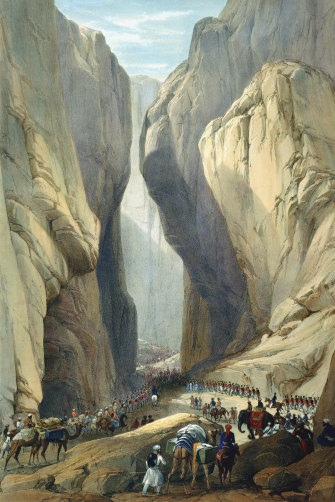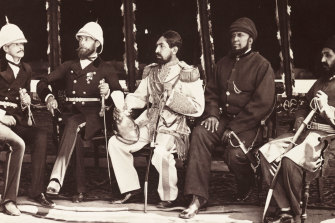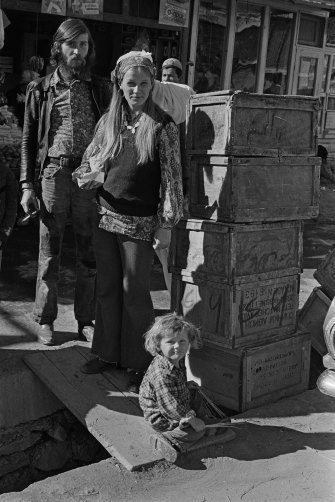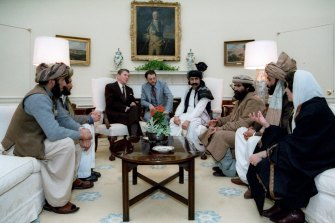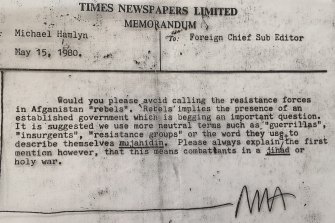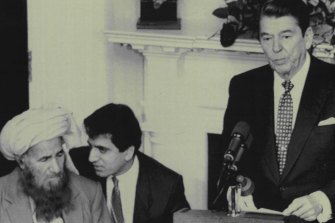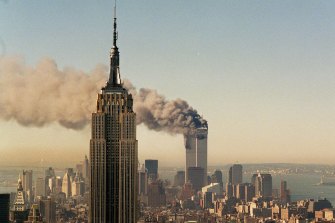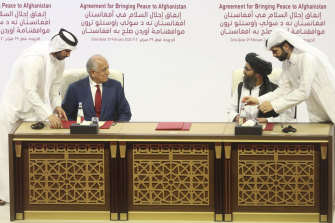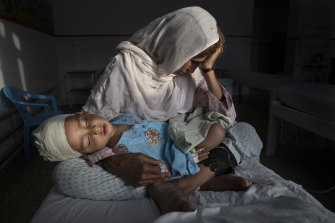Miniskirts and mujahideen: how did Afghanistan come to be defined by war?
It was once a stop on the hippie trail and inspiration for the Lonely Planet guidebooks. So how did Afghanistan come to be defined by war and terrorism?
As Donald Trump's aides packed boxes for the President's final withdrawal from the White House, one of the last men he ever appointed to an important government job released a statement on Friday, January 15, local time, to say that his mission had been accomplished: the US had withdrawn all but 2500 troops from Afghanistan, the lowest number of American boots on the ground in 20 years.
"This drawdown brings US forces in the country to their lowest levels since 2001," said acting defence secretary Christopher Miller. Warming up in his missive of self-congratulation, he also said "the United States is closer than ever to ending nearly two decades of war and welcoming in an Afghan-owned, Afghan-led peace process to achieve a political settlement and a permanent and comprehensive ceasefire".
It's a pretty thought but nothing attempted in Afghanistan in several decades has achieved peace, and many fear this new withdrawal will only make things worse.
It's slightly later than planned. Trump had ordered the troops home for Christmas, to the open dismay of his generals and Republican colleagues, and he'd had to dismiss his previous defence secretary Mark Esper on November 10 to get it done.
Trump's decision to pull the troops prompted Senate Majority leader Mitch McConnell, still then loyal to the President and not yet acknowledging Democrat Joe Biden's victory, to push back.
"A rapid withdrawal of US forces from Afghanistan now would hurt our allies and delight the people who wish us harm," McConnell told his fellow senators. "It would be reminiscent of the humiliating American departure from Saigon in 1975."
United States soldiers and their allies in the "war on terror"have been fighting in Afghanistan for almost 20 years. It has become the longest war in US history, characterised by Trump and many of his supporters as an “endless” or “forever war” that he pledged to end.
Australia's military engagement in Afghanistan, as part of Operation Slipper, lasted 13 years and was also the longest in our nation's history. It ended in 2014, in the words of then prime minister Tony Abbott, “not with victory, not with defeat, but with, we hope, an Afghanistan that is better for our presence here".
That hope has been put to the test in the years since by investigations into the conduct of Australian special forces (which did the bulk of this country’s fighting in Afghanistan) culminating in the publication of the Brereton report in 2020, which found that 19 current or former special forces soldiers should face criminal investigation over 39 alleged murders of non-combatants.
Why has a country that was once a stop on the hippie trail and inspiration for the Lonely Planet guide books come to be defined by war and terrorism? How did troops of the US-led coalition end up being there for decades? Did the CIA create the Taliban? And what might the future hold for Afghans?
A depiction by army surgeon James Atkinson of British troops entering Afghanistan through the Bolan Pass in 1839. They were massacred in a retreat through the Khyber Pass three years later.Credit:Getty Images
Is Afghanistan really "the graveyard of empires"?
The one thing everyone knows about Afghanistan is that it cannot be conquered. As this story goes, every army since Alexander the Great's in 330BC has had to leave in defeat (though Alexander, or Iskander as he was known in the East, left his name on Kandahar, the country's first capital).
The British, who fought three wars in Afghanistan between 1838 and 1919, did much to popularise the idea of it as inhospitable and unattainable. (Britain lost the first war but the other two could be called draws.) When Arthur Conan Doyle's Sherlock Holmes meets Dr Watson for the first time, he remarks "you have been in Afghanistan, I perceive" and later Watson recalls seeing "comrades hacked to pieces at [the 1880 battle of] Maiwand". In his poem The Young British Soldier, Rudyard Kipling had the last grim word:
When you're wounded and left on Afghanistan's plains,
And the women come out to cut up what remains,
Jest roll to your rifle and blow out your brains
An' go to your Gawd like a soldier.
British diplomat Major Sir Pierre Louis Napoleon Cavagnari (second from left) was set to take up the post of British envoy in Kabul when the British residency came under attack in 1879 and he was killed, leading the British to resume war in Afghanistan. Credit:Getty Images
Three things should be said about this account. Firstly, while travellers and mapmakers had for centuries talked about "the land of Afghans", or Afghanistan in Persian, there wasn't a country called Afghanistan until the 18th century. Secondly, by that time the area had been conquered repeatedly by Persians, Arabs, Mongols and Indians – peoples whose history is not always closely studied in the West.
Thirdly, and most importantly, Afghanistan is a place on the edge of every place, a landlocked crossroads at the easternmost limits of the Middle East, the westernmost limits of the Far East, the northernmost limits of South Asia and the southernmost limits of Central Asia. Empires haven't been killed there, but they have often found the end of their reach.
This has meant that, again and again, they have sought controlling influence over Afghanistan's affairs without having to rule there, or as Britain's viceroy in India, Lord Curzon, put it in 1906: "We do not want to occupy it, but we also cannot afford to see it occupied by our foes."
What about the people who live there?
"As an Afghan you are always more than one thing: your kin, your tribe, your ethnicity and the place you were born … As a foreigner, you can never truly understand what it means to be an Afghan."
So wrote Abdul Salam Zaeef, one of the founders of the Taliban (on whom more later). At a crossroads, one often encounters a kaleidoscope of people, and Afghanistan has long been home not only to Pashtuns such as Zaeef (once the only people the name "Afghans" referred to) but also Persian-speaking Tajiks and Hazaras, Turkic-speaking Uzbeks and at least a dozen other ethnic groups.
Its remoteness also gave it allure for Western travellers. In 1955, to promote its new line of go-anywhere jeeps, Land Rover sponsored the Oxford and Cambridge Far Eastern Expedition, which saw graduates travel overland from Europe along the long-defunct Silk Road. They were supplied with film to record their journey by a young producer at the BBC, David Attenborough.
A hippie family in Afghanistan in 1971.Credit:Getty Images
Programs such as the ones created from their footage and books such as Eric Newby's A Short Walk in the Hindu Kush – a mountain range that runs through Afghanistan – inspired waves of young people to set off on a quest to the "mystic East". Eventually this would become the "hippie trail", featuring the hashish Afghans had always grown and smoked.
One visitor particularly awestruck by the country's cities, mountains and wilderness was Tony Wheeler. He and his wife Maureen drove across Afghanistan en route from London to Sydney and wrote a booklet about the journey, Across Asia on the Cheap, that effectively founded the Lonely Planet publishing empire.
In the '60s and early '70s visitors would have found traditional rural societies as well as cities where young Afghans wrestled with modernity in all its forms, from Marxism to the miniskirt. Indeed, it is said that when short-lived national security adviser HR McMaster wanted to convince Trump that the country was not irredeemable and that troops should be kept there, he showed him a photo of three miniskirted students on a Kabul street in 1972.
There was one other constant in Afghan life: Islam. For the hippies it would have been part of the exotic furniture. But as the 1970s progressed and conflict and dictatorship reared their heads, for many Afghans it became the last safe space for political activity.
US president Ronald Reagan meets an Afghan delegation at the White House in 1983. While Reagan would later receive mujahideen leaders at the White House, only one of the Afghans seen here is a combatant – Mohammad Ghafoor Yousafzai, third from right. Credit:Wikimedia Commons
Why did the Americans get interested?
When we look at a map today, Afghanistan is bordered to the north by a number of other Central Asian ’stans. But for most of the 20th century those republics were part of the Soviet Union, ruled from Moscow. Just as the British in India had kept a nervous eye on the Russian Empire during the 19th century in what became known as The Great Game, after World War II the US saw Afghanistan through the lens of its Cold War “domino theory”, where the fall of one country to communism would mean the same for its neighbours.
By the late 1970s, despite investment by Washington in agriculture, schools and power plants, Moscow had the upper hand, and in 1978 a coup brought communists to power in Kabul. Their efforts to supplant tribal authority and enact land reform provoked resistance. At first Moscow refused to become directly involved but, after a second coup in September 1979, Soviet troops entered Afghanistan to install a loyal government, closing the border and forcing “hippie” travellers to make a detour.
The Soviet invasion presented Washington with an opportunity to create a Vietnam-like quagmire for Moscow. US president Jimmy Carter had already begun covertly funding anti-communist militants in Afghanistan through the CIA’s Operation Cyclone. The invasion prompted the US-led boycott of the Moscow Olympics. Under Carter’s successor, Ronald Reagan, Cyclone’s budget would grow from hundreds of thousands to hundreds of millions of dollars a year, and those doing the fighting against the Russians would bring a new word into the English lexicon: mujahideen.
Michael Hamlyn, a correspondent for <i>The Times</i> of London, explains a new word to editors.
Today, when the word jihad (in this context, a war Muslims consider just) has become feared around the world, it is jarring to hear Reagan refer to the mujahideen – the plural of the Arabic word mujahid, or "one who undertakes jihad" – as "the true representatives" of "a nation of heroes".
Cyclone's funding would be added to by Muhammad Zia-ul-Haq, the dictator of neighbouring Pakistan, and the oil-rich Arab monarchies of the Persian Gulf. By the time the Soviets finally withdrew in 1989, billions of dollars' worth of weaponry and equipment had flooded an impoverished nation where unified government was a memory.
Pakistan's north-west frontier, largely populated by Pashtuns with tribal connections across the border, had seen millions of Afghan refugees flee south in the 1980s. Its main city, Peshawar, became the gateway for those seeking to join the fight to the north.
November 12, 1987: US president Ronald Reagan tells a White House audience that mujahideen leader Yunus Khalis (left) represents "a nation of heroes". Translating for Khalis is State Department official Zalmay Khalilzad, later the Trump administration's envoy to Afghanistan.Credit:AP
Who are the Taliban? How are they linked to Osama bin Laden?
The rhetoric of the war against the “godless communists” meant the mujahideen had always included Afghan youths who were originally students of Islam rather than warriors. The Pashto word for such a student is talib, and taliban is plural.
When the communists in Kabul finally fell in 1992, only to be replaced by ethnic and party-based warfare between the mujahideen, a number of these students in 1994 began an armed movement in southern Kandahar province to end internecine strife, making rigid application of Islamic doctrine and courts their hallmark. Swearing allegiance to a religious teacher and mujahid called Mohammed Omar at a tiny whitewashed mud mosque in the village of Sangisar, they took the name Taliban.
Above: Osama bin Laden (right) with Egyptian Ayman al-Zawahiri, who leads al-Qaeda today, in 2003. Both are dressed as Afghans, though they are Arabs.
For war-weary Afghans, especially in the rural and majority-Pashtun south, destruction of arms stockpiles in the name of national unity as well as calls for an end to bribery and lawlessness resonated strongly. Within two years the Taliban had swept north into Kabul and declared a new state, the Islamic Emirate of Afghanistan. It would be formally recognised by three countries: Pakistan, Saudi Arabia and the United Arab Emirates.
Another group had been disenchanted by the descent into factional war: Muslims, particularly those from Arab countries, who had formed a kind of international brigade against the Soviets. In 1988, a number of these "Arab Afghans" became a clandestine Islamist group called al-Qaeda ("the Base").
After the Soviet withdrawal and with foreign funding drying up, many would go home or move to other war zones in the Muslim world. But one would eventually come back: Osama bin Laden, al-Qaeda's Saudi Arabian founder. By the time he and his followers returned in 1996, he was a fugitive from US and Saudi authorities and the Taliban were rulers. In a fateful decision, they agreed to grant him safe haven.
The twin towers of the World Trade Centre burn behind the Empire State Building in New York, after the terrorist attack of September 11, 2001.Credit:AP
Is the war in Afghanistan unwinnable?
It is unlikely we will ever know for certain how much the Taliban leadership knew about al-Qaeda's horrific plan to use passenger jets as explosive devices targeting the World Trade Centre and the Pentagon on September 11, 2001. But by the time the US and its allies began their "war on terrorism" that October, both the Taliban and al-Qaeda were in their sights.
It was clear that this would mean an end to the Taliban's "Islamic Emirate". But what else it might mean seems to have been unclear to even the most senior political and military planners of the US-led coalition.
There were few places the Taliban could look for sympathy. Their rule had become a byword for religious oppression, excluding women from public life and girls from education, banning traditional and modern pastimes from kite-flying to television and meting out savage punishments in the name of Islam. Their destruction of two giant 6th-century statues of Buddha in Bamiyan set the seal on their reputation for barbarism.
But just as invading Afghanistan showed the limits of Washington's reach, overthrowing the Taliban exposed the country's old divisions; the power struggles of the mujahideen leaders returned. At an assembly to ratify a new constitution in 2003, a young woman called Malalai Joya reminded them of their role in the bloodshed of the 1990s, as this clip shows, before she was ejected from the assembly:
Caught between a series of elected governments dependent on Western support and an insurgency that wouldn't end, US president Barack Obama announced a "surge" that brought foreign troop numbers in Afghanistan to 130,000. In 2011, Bin Laden was killed in Pakistan and US defence secretary Robert Gates revealed US talks with the Taliban. By 2013, the US had withdrawn most of its troops and the Taliban had been allowed to open a "negotiations office" in the Gulf state of Qatar.
The Taliban – for all their crimes, an indigenous movement – have kept up attacks on foreign and Afghan forces and a campaign of terror against civilians, using the long Pakistan frontier as a rear base just as they did against the Soviets. They still control a significant portion of Afghanistan.
US envoy Zalmay Khalilzad (left) and Taliban leader Abdul Ghani Baradar sign the "Agreement for Bringing Peace to Afghanistan" in the Qatari capital Doha.Credit:AP
The US-led coalition's inability to achieve or define its military and political objectives was a factor in prolonging the war; key fighting units had to serve repeated deployments in the country.
Faced with enemies who were often irregular (non-uniformed) combatants hidden in the general population, and with what Paul Brereton in his report calls "[a] strategy … focused on killing or capturing insurgent leaders", some coalition troops crossed the line between the killing of combatants and non-combatants in an environment where "local nationals were presumed to be hostile", a situation that ultimately led to Brereton’s inquiry into war crimes by Australians.
In February 2020, Trump's envoy Zalmay Khalilzad – an Afghan-born American involved in high-level contacts since the Reagan era – and the Taliban signed an accord in Qatar aimed at finally ending the US invasion.
In Kabul, a woman called Najiba holds her nephew Shabir, 2, injured in a bomb blast that killed his sister in 2016.Credit:Paula Bronstein
What could happen if foreign troops leave?
The internationally recognised government of Afghan President Ashraf Ghani is struggling not only with the Taliban but also – in a situation reminiscent of the recent US elections – with an opposition leader, Abdullah Abdullah, who claims to have been cheated of victory in the last two presidential elections and even had himself sworn in as president last year. In a bizarre twist, Ghani has since put Abdullah in charge of reconciliation talks with the Taliban.
Despite their recent commitments to the US, the Taliban – who insist they are the legitimate government of Afghanistan – retain strong links to al-Qaeda. Both the Taliban and al-Qaeda face a new terrorist rival – a local version of the so-called Islamic State is carrying out bombings and attacks, even hitting Kabul.
After decades of war, Afghanistan is dependent on billions of dollars in international aid (Australia contributed $82 million in 2019-20), with more than half the population below the poverty line. Some economists suggest that a way out of this dependency lies in untapped mineral resources including copper, emeralds and rare earth metals, with even our own Andrew “Twiggy” Forrest holding talks with the country's president. However, Chinese attempts to begin mining copper have failed and some experts argue the whole notion of an Afghan mining boom is a mirage given the security situation and lack of infrastructure.
The rise of the Taliban was supported by political and military figures in Pakistan, and as a result a Pakistani version of the movement has become powerful in that country's north-west, notoriously trying to kill education activist Malala Yousafzai. The Pakistani government sees control of Afghanistan as vital to its security, and cross-border solidarity between Pashtuns as a threat to its territorial integrity, so it will continue to sponsor militant groups there. It is not hard to imagine India, itself facing frontier problems in Kashmir, trying to use anti-Pakistan feeling to its advantage.
What seems certain is that even if Afghanistan does fade from the headlines, it will only be a matter of time before we are back at the crossroads.
If you'd like some expert background on an issue or a news event, drop us a line at [email protected] or [email protected]. Read more explainers here.
Most Viewed in World
Source: Read Full Article

